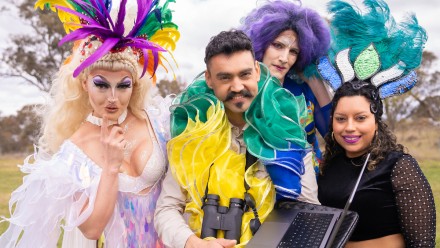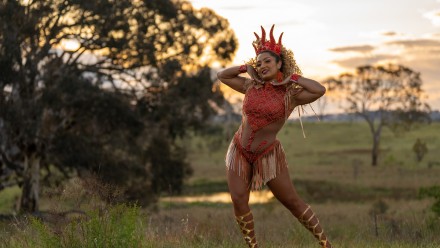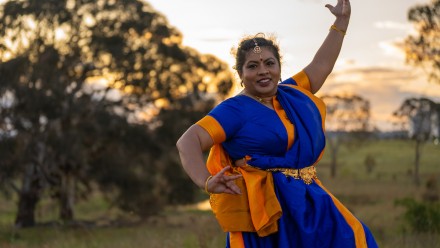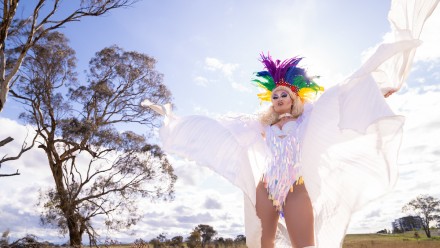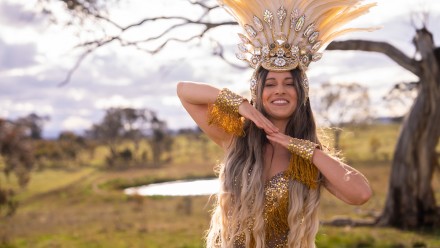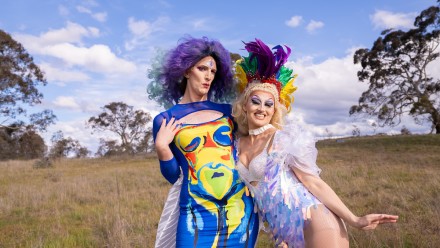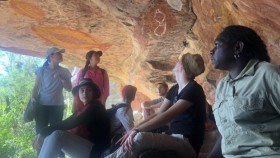‘It’s like winning Eurovision’: an ANU graduate’s journey from kangaroo whisperer to global dance sensation
What do drag queens, Brazilian funk dancers and biologists have in common? No, this isn’t the beginning of a corny dad joke, which, let’s face it, aren’t great at the best of times.
There’s no punchline here, although you may be forgiven for thinking otherwise. In fact, this forms the premise of an important experiment conducted in the name of science. And which is now going gangbusters globally.
The common denominator here is that they all convey the different personality traits of a certain beloved Aussie marsupial. Confused? Well, let’s hop to it.
‘Kangaroo Time (Club Edit)’ is the wickedly creative vision of singer-songwriter, creator and biologist Dr Weliton Menário Costa, or ‘WELI’ as he’s known in social circles, a PhD graduate from The Australian National University (ANU).
WELI weaves together a funky beat, original songwriting, colourful costumes, and a whole lot of sequins to create something that’s both entertaining and educational; the final product is something that looks like it’s been plucked straight out of The Adventures of Priscilla, Queen of the Desert.
A testament to WELI’s creative prowess, the music video, which he stars in and directs, has been crowned winner of the global Dance your PhD competition, an annual contest where researchers around the world are tasked with explaining their PhD in the simplest of terms through song and dance.
WELI, who is one of the world’s leading researchers in kangaroo behaviour, is the first person from ANU to win the Dance Your PhD competition, and just the fourth person from an Australian institution to do so since its inception in 2008.
“Winning this contest is the equivalent of winning Eurovision for me. I think it not only shows the incredible might of the research conducted here in Australia, but also how creative we are as a nation. Even us scientists!” laughs WELI.
Perhaps surprisingly, WELI admits there was “very little” creative direction or instructions given to the performers prior to the shoot.
“I didn’t want the performers to know too much about the creative vision beforehand. That was very important to me because I wanted everyone to do what felt right to them, in that moment,” he explains.
“There was no choreography involved. The dancers improvised their movements, responding to one another’s cues and interacting with each other. The only direction I gave them was to come as you are and showcase your style in your own way.
“It was very magical seeing all these people coming very engaged and bringing their best to the scene.”
In 2017, WELI relocated from his home country of Brazil to Canberra to undertake a PhD in animal behaviour at the ANU Research School of Biology, which he finished in 2021.
Armed with a remote-controlled car, the ANU graduate spent more than three years studying the spectrum of behavioural differences of a group of more than 300 wild eastern grey kangaroos in Victoria.
“We wanted to see how the roos react to the strange sight of an unfamiliar object. We wanted to find out whether they’d hop away, stay put, or if they’d be curious enough to approach the car. Our experiments also involved walking directly towards a kangaroo to see how the animal would react,” he says.
“We found that kangaroos like to socialise in groups but prefer smaller social circles. Like humans, kangaroo personalities manifest early in life. Mothers and their offspring have similar personalities, and so do siblings.”
The video aims to demonstrate that kangaroos have distinct personality traits. According to WELI, these differences become more apparent when the animals are in groups because they change their behaviour when they’re in a social setting, adjusting as they move between groups.
“Kangaroos are very socially aware and will adjust their behaviour based off cues from other roos,” he explains.
“The diversity of the dancers in the video, from classical ballet to twerking, and the urban street dancers to the Brazilian dancing styles, reflect the variations in kangaroo personality across the full spectrum, from bolder types to shier roos.”
Reflecting on the success of ‘Kangaroo Time’ and the global mark it’s made on the scientific community and further afield, WELI notes that at the core of his video is a message of inclusivity and diversity — something he hopes will be one of the main takeaways that viewers hold onto.
“As a queer immigrant from a linguistically diverse developing country, I understand the challenges of feeling disconnected in certain environments,” WELI admits.
“One of the main messages I wanted to convey through this piece of work is that differences lead to diversity, and this is evident throughout the entire video. It’s evident with the different dancers that herald from various cultures and backgrounds.
“I think it’s extremely important that we celebrate diversity and creating a video explaining kangaroo personality was an excellent medium for me to do this.”
WELI says one of the most challenging yet rewarding parts about creating the music video was being able to explain his PhD to his family and friends in his small Brazilian hometown in a simple but effective way without getting bogged down in the scientific jargon.
Ask any researcher attempting to distil complex scientific research into something easily digestible for the general public and they’ll tell you that’s no easy feat.
“My grandmother is now able to understand what my research is all about after watching my video,” he says. “I think it’s amazing to be able to condense years of research and numerous academic papers into an accessible, informative, and most of all, fun video.
“The project helps bridge the generational and educational gaps in my family, making science accessible and enjoyable through the power of creative storytelling.”
On the surface, ‘Kangaroo Time’ is an effective display of science communication that expertly utilises the creative arts medium. It’s engaging, quirky and niche. But WELI admits the decision to incorporate the words kangaroo time into the video’s title acts as a double entendre of sorts.
“The use of kangaroo time is not just to explain my research studying kangaroo personality — it’s also about my time living and studying in Australia as a whole. It’s been a time of exploration for me, a time where I’ve been able to reconnect with and grow my passion for music, dancing and the creative arts,” he says.
“Working on this project was the spark I needed to encourage me to take that next step with my music. It’s made me realise I want to focus on my music for the next little while and put my scientific career on the backburner.
“Speaking of which, I’m about to release a new EP called Yours Academically, Dr WELI.”
Despite the challenges of being an independent artist releasing their first single, WELI’s ‘Kangaroo Time (Club Edit)’ has already featured in clubs, festivals, dance classes and radio stations.
“The original and club mixes together have been played more than 7,000 times on Spotify,” he says.
“I think it would be super cool if after this everyone in Australia is singing and dancing to Kangaroo Time,” he laughs. “You never know.”
Check out ‘Kangaroo Time (Club Edit)’ on WELI’s YouTube channel.
Learn more about the Dance your PhD competition on the Science website.
This article was first published by ANU Reporter.






